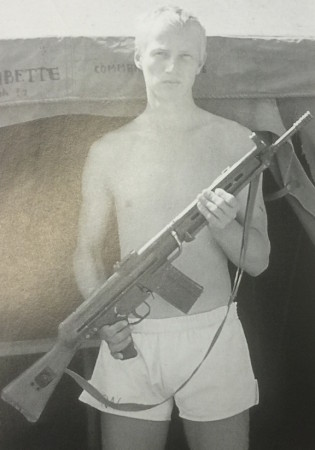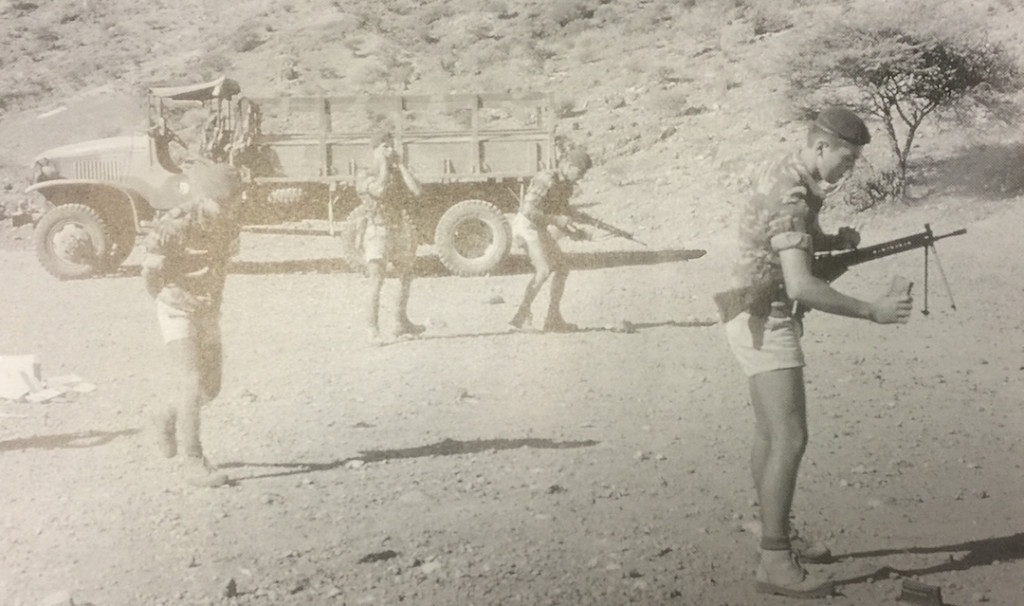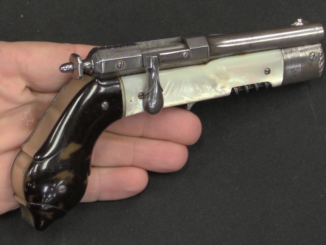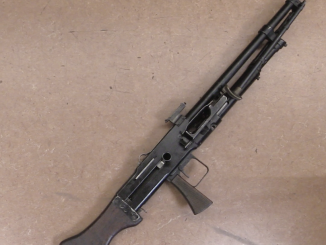
I was doing some reading up on the early roller-delayed rifles (in Blake Stevens’ exquisitely technical and detailed book Full Circle: A Treatise on Roller Locking) and came across this very cool story, which I wanted to share…
Spain formally adopted the CETME Model B in 1958. It was mechanically pretty much the same gun we know today as the CETME-C or G3, but still chambered for the 7.62 NATO-CETME cartridge. This was a Spanish response to the NATO cartridge requirements – it was dimensionally identical to the 7.62mm NATO but fired a 125 grain projectile at 2300 fps, rather than the 143gr @ 2790fps of the NATO standard. The Spanish saw that the standard cartridge was too powerful to be effective in a select-fire rifle, and the reduced load was developed to reduce recoil to a manageable level. This was done for only a few years, until they surrendered and adopted the Model C in 1964 using standard ammunition. The CETME-B would still use the NATO ammo, but it was rough on the guns.
Anyway, the French were busy fighting against Algerian rebels at this time, and in March 1961 a Danish freighter named the Margot Hansen was spotted by a French maritime patrol aircraft and stopped off the coast of Algeria. Upon boarding and inspection, it was discovered that the ship was carrying 200 brand new CETME-B rifles and ammunition for them, destined (illegally) to the ANL and FLN rebel groups. The arms were confiscated, of course, and put into storage at the French naval depot at Mers El Kebir. This depot held other seized weapons as well, mainly of German WWII origin – Kar 98k Mausers and StG-44 assault rifles. When the 200 CETMEs arrive, the quickly drew the attention of the French Marine Commandos who were stationed at the port.
The French at the time were using MAS 49/56 rifles, semiauto only, and with 10-round magazines. The supplementary full-auto firepower was provided by Chatellerault 24/29 light machine guns, which had 20-round box magazines (which were occasionally adapted to 49/56 rifles, but that is a different story). The Marine Commandos were very interested in this new rifle, which looked to offer the capabilities of both their rifles and LMGs in a single light package. Because they were a unit of the French Navy and the guns had been seized by the Navy and were stored in a Navy depot, the Commandos were able to requisition the guns and the seized ammo for their own use without much difficulty.

The one obstacle that did surface was when someone noticed that all the rifles were missing their firing pins. Why? Nobody knows for sure, but most likely because the smugglers were planning to hold them back for security or for an addition payment. It is also possible that the whole smuggling setup was actually a fake operation being run by the SDECE (French Army Intelligence), but any records that could confirm that are long since destroyed. At any rate, the Marines didn’t let a minor issue like firing pins stop them, and the depot machinists reverse engineered the design and manufactured a large supply. They were never able to get the material and heat treat quite right, and their firing pins apparently had a tendency to break frequently – so the Marines carried a bunch of spares whenever using the guns.
Another obstacle that developed was that the seized ammunition turned out to be garbage. It had been hastily made from components sent to be scrapped, and dimensions like overall length varied substantially. Some cases had no primer flash holes. Headstamps varied significantly, and were mixed within boxes. The men were able to source French-made 7.62mm ammunition, and wound up using those CETME-B rifles in active combat operations as late as 1978. Quite the colorful path for a batch of early Spanish rifles, ultimately used for decades against the very groups they were intended to aid!
How did the guns make it out of Spanish control? That’s a good question. They would have been first-line military arms at the time, not guns being surplussed or otherwise left about unattended. However, CETME was actively working with Dutch and German firms and military organizations at the time, and shipments of rifles could have been legitimately bound for either of those countries. Blake Stevens suggests one possibility for the source was such a shipment being rerouted by a man like notorious German arms smuggler Otto the Strange – although this can only be speculation.





As usual Ian, you are a wealth an absolute Wealth of information, well written/presented. I want more MORE!
What a fascinating story, thank you, Ian!
French Marine Commandos => 1 & 2 RPIMA => from SAS (french SAS squadron of WWII) with the Army
French Navay/Naval Commandos (Naval infantry) => Commando Marine (assault Divers and Naval Assault) from Special Service Brigade UK (WWII)
The Commandos de Marine had nothing to do with the Marine Parachute Infantry Regiments (RPIMA, formerly RPC’s, renamed in April,1958, well after the founding of the CdM), other than both being in the Réserve Général in Algeria. The CdM was formed under the guidance of the Royal Marines during WW2, hence why they wear the green beret and theirs are the only berets in the French military to fold to the right of the wearer’s head.
Ian: A correction: By the time the CETME shipment was intercepted, the CdM had been using the AA52 LMG for a few years. The FM 24/29 would have been a rare sight in that unit at that point. For an excellent resource on this unit, this book is indispensable: “De Penfentenyo: itinéraire du commande de marine, 1954-1962” by Jean Durantin.
The second picture with the Commandos and the truck looks like Djibouti- possibly Chad- not Algeria. Short shorts, tailored jackets, and tight berets were not the typical style in Algeria. Compare that to the last picture, which definitely is in Algeria.
Excellent article! Many thanks for a fantastic presentation.
I appreciate the corrections – I wrote cations based on what was written with the photos in “Full Circle”.
I’m happy to share my arcane and narrowly-focused knowledge. 🙂 Thanks for all of your work, on this article and the rest!
It’s ALN (Armée de Libération Nationale)
RPIMA Régiment Parachutiste d’Infanterie de Marine
Awesome info Ian!! As a long time collector of French rifles and pistols, now my 2 CETME’s can fall in line!! Keep up the good work!!
It’s a man bites dog story (sort of), given the vast garbage pile of weapons and ammo that was dumped on the Spanish Republicans a couple of decades before. If only the CETMEs had wound up in the hands of the Poles or the Russians, the circle would have been complete.
“German arms smuggler Otto the Strange” – off topic, but could somebody tell me who this is?
Indeed, he sounds like a man with a story.
He might be the sportman of this article ( https://www.theguardian.com/sport/2008/jun/29/olympicgames ) but we can not be sure because there is no mention about illegal trade
I know this thread is old but I think that’s a mistake. Otto the strange was a German track star from the 1920s/30s and a homosexual who fell out of favor with the Nazis. I think he means Otto Schlueter. He was an arms dealer for sure.
“a Spanish response to the NATO cartridge requirements – it was dimensionally identical to the 7.62mm NATO but fired a 125 grain projectile at 2300 fps, rather than the 143gr @ 2790fps of the NATO standard.”
Since the dimensions were identical, I foresee someone loading 7.62 NATO in the mag. The question I have is could this Spanish variant handle the heavier load safely?
FWIW. The received wisdom in southern Africa in the 70s to 90s was yes, with no discernible problems, IF one replaces the original recoil spring with a new G3 spring. If one doesn’t replace the spring NATO standard rounds will fully compress the original spring with each firing, AKA “bottoming out”. The weapon will work, at least for awhile, but sooner or later (Probably sooner.) the spring will fail, leading you back to the replacement you should have done in the first place. BTW recoil with an original spring and NATO ammunition is described as “Nasty.” Again, FWIW.
Wafa Wafa, Wasara Wasara.
Yes, I do. I shoot five rounds in semiauto and quite fast.
But I have doubts about whether the weapon would be able to keep the fire a long time.
Dear all,
I must appologize for my very poor English, sorry.
I am the one on the picture at the top of the article. I sent these pictures with some comments to Stevens when I was working at HK in Germany after my duty time in the French Navy (25 years with the Commando Marine). Steves mixed a little be my comments, maybe becauce my English is far to be be perfect…
Of course the two first pictures on this web side were not taken in Algeria but in Djibouti. The French Navy used the CETME rifles from the Algeria war to the end of the 70’s and were retired in the 80’s. I was the last user of these “old timmer” at the Commando De Pententenyo, with some M1 carbine and other old stuff. They were destoyed begining 2000 and a few survive as souvenir fixed on walls, deactivited unfortunatelly. The story about the SDECE (that is a branch of the Army, and not of the Police) is the most probable. I was one of they usual trick to “pump out” the finance of the FLN. That’s also the reason the rifles had no firing pin in. The Navy never find the original firing pin and the Navy gunsmiths makes new one but not strong enought for the confiscated weapons and ammo. For the story, we use these ammo until the 80’s. All the ammo had Dutch headstamps and was of low quality (like rejected by the Dutch Army).
The stories about the different weapons sened to Algeria in the 60’s by smugglers are very interesting. But this one about the CETME is certainly the most strange because the CETME was the most modern weapon at this time. The question is: how are these weapon comming out of the inventory of the Dutch, Spanish or German arsenals???
Have a nice day, and once ago, sorry for my bad English.
Wolf
Thank you for the comment, Wolf! I changes a couple details in my article to be more correct.
Superb story and comment, merçi beaucoup. If I remember correctly there was a lot of diplomatic troubles, but quite under the radar, between France and West Germany during the Algerian War. With the French special services capturing/killing members of the FLN in german cities and many germans, with the help of some services, doing ”business” with the algerians including bank accounts, arms traffic etc…this was some years before the new franco-german friendshio with De Gaulle and Adenauer. So maybe the german connection is the correct one, I insiste, maybe.
For the spanish it would be quite stupid to directly aid the algerians as they have fought alongside the french in the Ifni war against Morrocco ( https://en.wikipedia.org/wiki/Ifni_War ) in 1957/8 and they still have their west saharian colonies at the time, France was in fact the only ally for them in the region.
SDECE and its “teeth”- the 11e Bataillon Parachutiste de Choc- were tasked with crippling the FLN/ALN supply and finance network both within Algeria and without. Assassinations of high-ranking FLN/ALN members in Algeria- the most famous being via a radio bomb- and their external operatives and weapons dealers in Europe- particularly West Germany and Italy- willing to to do business with them were SOP. Most of the ships carrying materiel destined for the FLN/ALN were intercepted either in part or in whole by 11e Choc. Aircraft bound for Tunisia or Morocco carrying FLN cargo were destroyed on the ground. [The relationship of the SDECE and 11e Choc would be analogous to the CIA having its own SOF battalion.]
It is highly, highly doubtful that Franco’s Spain would offer any assistance to the FLN. It is at least remotely plausible that the CETMEs were part of an SDECE operation, and the idea that the Marine National had no knowledge would not have been surprising.
Use it if you have it. Interesting article. I didn’t know the original rifle had its own loading for the 7.62 NATO, makes perfect sence though if you want control for bursts or full mag dumps.
This is pretty extensive information and for great part new to me.
the French ground forces, with its individual branches, appear to be versed with varied selection of firearms. In the current selection process for new French service rifle are several different models, although restriction is imposed as far as EU origin only. It appears that HK has a unique chance again to place its product. With this background in HK/Cetme, who else would it be anyway?
Dear all,
At this moment nobody can say which weapon would be selected by the French Army. The selection is not finish and all the competitors are not out ; H&K, FN Herstal, Beretta, HS Croatia and SIG. end of the test at the end of this year.
The rumours says that the last choice would be between H&H and FN…
Wait and see.
Wolf
Thanks for your view, Wolf.
It is good to see here a person as well informed as you are. I wonder if CZ participation was terminated; maybe I missed the news. They have the upgraded CZ806 now.
Hi Denny,
Sorry for my poor English.
CZ was really unlucky in this tender. He was the 5th competitor in this competition. unfortunately his paperwork was not good in certain aspect and the French DGA rejected it. so HS Croatia take his place.
In my point of view, the CZ product is a very good stuff and it was a chance for the main competitors (especially H&K and FN) that the CZ paperwork was not good.
Wolf
Interesting, paperwork huh? Oh well, they sell elsewhere including States. Your English is next to perfect btw, better than mine for sure. 🙂
The original spanish reduced load had a 113 gr with a plastic tip under the jacket, loaded to about 2600 fps. But it was quickly changed to the reduced veloctiy load mentioned above with the normal lead core bullet.
What is the main reason for firing pin breakage, and why their gunsmiths could not get it right? Is there particular tricks and stuff one should know about to get it right, some special heat treatment method or what…
Firing pin on firearm equipped with rotating hammer you have complex stress load. Part of it is wiping action of hammer which adds to usual compression also bending. Then, you may have omitted radius here or there or surface finish and here you go – you have a breakage.
Material is of importance and so is method of H/T part of post treatment processing, such as bead blasting. If any of this is neglected, you end up as described.
Hi you all, hi Storm,
The reason we had so mainy Brocken firing pins are:
– They had (the gunsmith)no original firing pin to copy them correctly, and they use very ordinary steel
– The ammo we used were not destiny for CETME rifles. The ammo was too strng and very close to the US NATO cartridge. The original CETME ammo is not so powerful than the NATO cartridge. During my duty time we used the rest of the ammo that was confiscated during the Algerian conflict, and, of course, french made Nato ammo. These ammo are more powerful than the Spanish ammo and every CETME user in my Commando takes 3 or 4 spare firing pin. Sometimes it break at 10 rounds and sometimes at 5000…..
Wolf
salut wolf
j’étais en train de rechercher ce que tu devenais après toutes ces années quand je suis tombé sur ton article sur la cetme. dejà je suis content de savoir que tu es toujours de ce monde , moi aussi … donnes moi de tes nouvelles
philippe boisgibault
Salut BGB, c’est assez marrant d’avoir de tes nouvelles par ce biais.
Tu peux me contacter au wolf.tre@wanadoo.fr.
W
I would wager that the problem was due to improper steel selection and improper hardening, not the ammo (although that would affect other parts of the rifle).
To see the picture of this gunsmith made replacement FP and original factory one would be the most interesting, so we can compare what was not done right…
I reckon it exists somewhere, if they made them in big numbers due to the short service life of one.
congratulations for your web-site. the french marine commandos one of the world’s finest amphibious warfare units.
Dear All,
I find some cartridges that was captured with the CETME in Algeria. It seems that the quantity of these ammo was large because we use them and finish the stock un the 80’s.
I had try to include some pictures of these ammo in the email but that doesn’t work, I don’t know why. Is there a way to send these picture on the “Forgotten Weapon” web site?
Wolf
Here i let you this is a youtube video link where are mixed real documentary footage images with a 60´s spanish patriotic-propagandistic film about Sidi-ifni war where this CETME rifle model is quite present.
https://www.youtube.com/watch?v=TGIzGeqry1A
I think I saw one of these in the Central Army Museum of Algiers